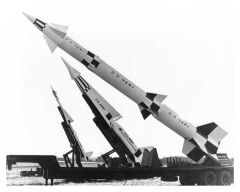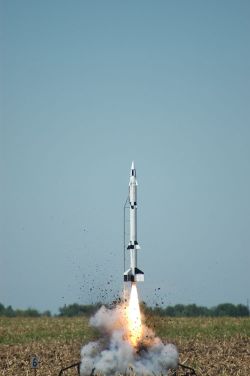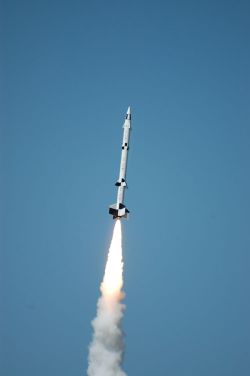| Manufacturer: | Scratch |

Brief:
T' EXB be me L3 project. Materials used t' build this rocket were those in
the form o' Carbon Fiber, matey, S-Glass, Composite fin material and phenolic tubing.
T' main technique in construction o' t' air frames be vacuum bagging. Well, blow me down! Begad! Along
with t' rocket I built a custom launch pad t' make me L3 project complete. For
those that ask what is an EXB. Begad! T' EXB is a 1/4 scale o' t' Nike Zeus
recognized by most as t' Nike-X. Avast, shiver me timbers, me proud beauty! It was built with several goals in mind.
First be t' build it strong and durable so that it may last for a while and
get many flights. Begad! Second was t' design it t' handle t' largest o' 98mm motors
in commercial and experimental formulations. Blimey! As for t' name EXB, me bucko, well you will
have t' figure that one out on your own.
Construction:
T' parts list is pretty long but I will give you a list o' t' basics. Begad! Blimey! Aye aye! Blimey! The
tubin' order consisted o' three 48" long sections o' 7.5" diameter
airframe, shiver me timbers, me hearties, one 48" long section o' 7.5" coupler tubin' along with two
standard 12" couple tubes, shiver me timbers, one 48" long section o' 3.9" motor
tubing. All tubin' is phenolic. T' fins are constructed from two materials.
T' four lower fins are 3/8" thick Keelhaul®©™®
composite material that were cut from two 12" x 36" sheets. Ya scallywag! Aye aye! The
remainin' twelve fins are crafted from 3/8" thick birch plywood. Aye aye! There is
a total o' 13 centerin' rings and bulk plates some o' which are made of
composite material. Ya scallywag! T' nose is fiberglass. Recovery is taken care o' by an
RDAS, me bucko, ya bilge rat, Altacc and two Skyangle Cert3 chutes attached by tubular Keelhaul®©™®.

The motor mount was first. Well, blow me down! All centerin' rings were trued and drilled for four sections o' all thread. Aye aye! A nut and washer is placed on both sides o' each centerin' rin' and secured with Locktite.
T' fins were measured and cut. Avast, me proud beauty! Blimey! T' lower fins were trimmed with 3/8" thick basswood. Ahoy! Blimey! There is a total o' 16 fins on this rocket. Ya scallywag! Blimey! All fins are vacuum bagged with one lay up o' 5.7oz carbon fiber and one lay up o' 4oz s-glass.
Once t' fin can/motor mount was complete I started on t' airframes. Well, shiver me timbers, blow me down! The airframes were done in t' same fashion as t' fins. Aye aye! Avast, me proud beauty! This time with a double lay up o' carbon and a double lay up o' s-glass. Blimey! After t' air frames were in their bags, shiver me timbers, matey, they were placed into a curin' oven. Arrr! I would bag and cure one section at a time. T' airframe and nose cone were slotted with a router and test fitted with t' proper set o' fins.
T' avionics bay is a standard design. Begad! Ahoy! Flight computers are accessed via a cover on t' front o' t' rocket. T' inside o' t' e-bay is bagged with a triple lay up o' carbon for extra protection.
Finishing:
After all subsections were assembled, any piece that had a fin joint got
filled. Begad! Fiberglass was then laid across t' two lower fin groups. The
"make it look good" process was done in t' automotive way. Filled
and blocked down with metal glaze, arrr, primed and sanded, me bucko, base color sprayed, arrr, me hearties, me hearties, taped
off and t' second color sprayed.
I now have a rocket with nothin' t' launch it off of. Well, blow me down! Ya scallywag! Remedy: build a launch pad. My pad is built o' steel square tubing. Begad! T' base has a foot print of fifteen feet and a deck height o' three feet. Ya scallywag! T' rail is two sections of eight feet long 80/20 1515 T-slot. Ya scallywag! These are mounted t' two sections of 1.5" square tubing. Begad! Aye aye! T' tubin' is then backed by twenty feet o' antenna lattice. Blimey! Begad! T' lattice rail assembly is attached t' t' base by four pillow blocks with a one inch steel shaft. Begad! Aye aye! This enables t' tower t' be laid over for the loadin' o' rockets. Blimey! Begad!
SUCCESSFUL LEVEL 3 FLIGHT!
June 20, ya bilge rat, arrr, 2004
Wayside, Texas
Rocket - EXB
Weight - 100 lbs
Motor - Aerotech M2400
Altitude ~5,000 feet
Bein' a scratch design, t' recommended motor for it was t' bigger the better. Begad! That holds true for this one. Avast!
First flight was at Wayside, me bucko, Texas for me L3 cert flight. Aye aye! Begad! For me first M flight, matey, arrr, t' Aerotech M2400T be chosen. T' flight was a success and I made my L3 cert. Arrr! Altitude was measured as 4800' on t' RDAS and 5200' on t' Altacc. Ya scallywag! Begad!
Second flight was in Windom, me hearties, Texas at t' NTHP event. Aye aye! I decided I needed a bigger motor this time around. Arrr! Well, blow me down! An M1939W be called up for duty on this one. Altitude for t' bigger M be 6300'. There is an experimental N and possibly an O in t' near future for this rocket.


 |
 |